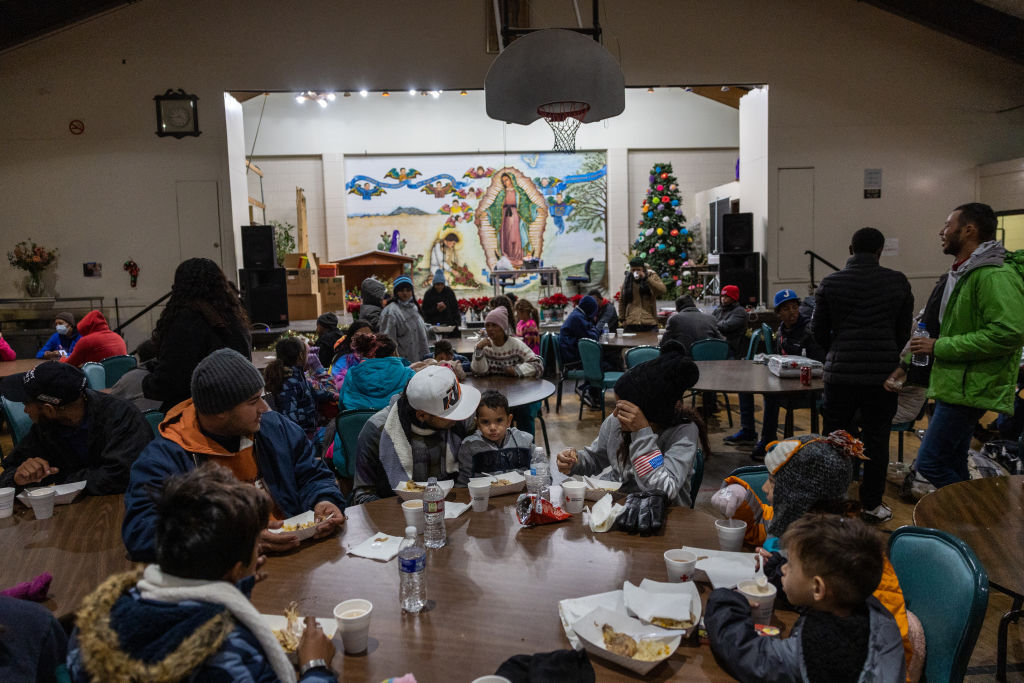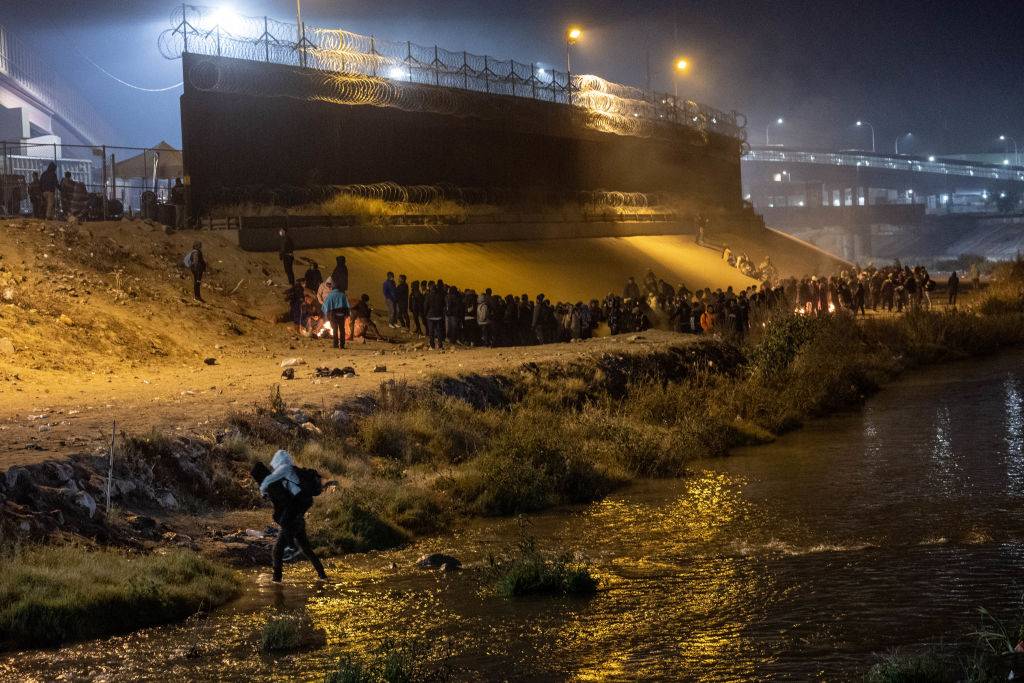
More than one hundred migrants gathered on the sidewalk outside of Sacred Heart Catholic Church in Downtown El Paso, Texas on Monday evening waiting for the church to open up for food services. Children huddled under blankets while others waited in line for bottles of water distributed by volunteers.
But not all of them were able to get a free meal: a church organizer announced they would serve women and children first, and men ages 18 and older would have to wait or find another shelter.
Sacred Heart Church, and other organizations and volunteers in El Paso, Texas, have for decades come to the aid of newly arrived migrants. Some say the number of arriving migrants from Latin America they’ve seen in recent days far surpasses what they typically encounter, squeezing the city’s resources at a precarious time for U.S. border policy. Though the government has not yet released December or November data, the El Paso sector of the border saw a dramatic spike in encounters in the most recently available data—there were more than 29,700 encounters in August, more than 49,000 in September, and more than 53,200 in October, according to U.S. Customs and Border Protection (CBP). The Department of Homeland Security (DHS), which oversees CBP and U.S. Border Patrol, on Tuesday said it has moved more than 3,400 migrants out of El Paso over the past week through Title 42 expulsions to Mexico or to their home countries.
In the past few days, hundreds of migrants have gathered along the banks of the Rio Grande river on the Ciudad Juárez side of the border, and many have lined up to present themselves to CBP officials in the hopes of making a claim for asylum. The line of people gathered outside the El Paso border has captured national attention, and those who CBP has permitted to cross into El Paso quickly filled local shelters. Many have had to sleep outside in the cold.
“I don’t think [El Paso has] the capacity or the money, the financial resources, to adequately welcome so many people,” says Nicolas Palazzo, a staff attorney at the Las Americas Immigrant advocacy Center, an El Paso nonprofit that provides immigrants with legal services.
The situation has been exacerbated by an eleventh hour pause on an expected change to how migrants are processed. Per a court order, the U.S. was scheduled to end a pandemic-era rule known as Title 42 on Wednesday, but the Supreme Court temporarily halted ending the program just two days ahead of the deadline after Republican attorneys general from 19 states appealed to the high court. What comes next is a mystery to border organizers who work directly with migrants.
Title 42, a public health measure aimed at mitigating the spread of COVID-19, has been utilized by the government since March 2020. Through Title 42, CBP can immediately expel migrants of certain nationalities either back to Mexico or their home country, even if the migrant wishes to claim asylum. The policy has largely prevented most migrants from entering the U.S. to claim asylum.
Some advocates and Democratic lawmakers say it’s time to stop the measure: “Title 42 is a public health order,” says Palazzo. “It is about containing the transmission of COVID, but it’s been worked into our de facto border policy.” The Biden Administration has been seeking to end Title 42 since April. Last month, a federal judge determined that Title 42 was unlawful and said the government had until Dec. 21 to end the policy. But Republicans and some Democrats have argued that ending Title 42 would lead to an increase in border crossings that the government does not have the capability to handle, and the policy continues to be litigated.

DHS has said that when Title 42 lifts, border policy would return back to the processing that existed prior to the Trump Administration. People who presented themselves to border agents, or who were caught attempting to illegally enter the U.S., would be be processed under Title 8, which would mean they could enter into CBP or Immigration and Customs Enforcement (ICE) custody, they could be immediately deported under “expedited removal,” or an immigration judge could determine whether the person would be permitted to remain in the U.S.
On Tuesday, DHS Secretary Alejandro Mayorkas said in a public statement that the agency would continue to expel migrants under Title 42 per the Supreme Court’s order. “While this stage of the litigation proceeds, we will continue our preparations to manage the border in a safe, orderly, and humane way when the Title 42 public health order lifts,” he said.
White House Press Secretary Karine Jean-Pierre told reporters on Tuesday that the White House is requesting $3.5 billion from Congress to scale up processing capabilities at the border, including transportation services, holding facilities, and increasing the number of agents at the border.
It’s unclear whether the migrants forming a line outside of the El Paso border came expecting the end of Title 42. Many have been permitted to enter the U.S. because of their nationality—Nicaraguans, Cubans, and others, for example, can’t be expelled to Mexico or their home countries, and so aren’t subject to Title 42—or because they’ve proven to CBP that they have other sorts of vulnerabilities.
The city of El Paso provided transportation to hotels for migrants when they began crowding the streets. At the El Paso International Airport, migrants have been filling benches and sleeping on the floor. But the city’s resources couldn’t keep up. On Dec. 17, El Paso Mayor Oscar Leeser declared a state of emergency. “I really believe that today our asylum seekers are not safe as we have hundreds and hundreds on the streets, and that’s not the way we want to treat people,” he said.
Local volunteers have gathered resources, passing out blankets and food. The El Pasoans Fighting Hunger Food Bank is setting up kits that contain diapers and baby formula. The American Red Cross is supplying cots and hygiene products. In Downtown El Paso, volunteers set up an internet tent outside of a McDonald’s so migrants can reconnect with loved ones.
“El Paso is a really friendly place, so we see a lot of cars coming down here dropping things off, dropping food, clothes,” says Alicia Gomez, a local volunteer. “This is not anything new [for the community], but obviously the number is a lot larger.”
On Monday evening, Gomez, her husband, and a coworker, Nancy Rodriguez, were roaming the streets in front Sacred Heart Catholic Church, passing out clothing so migrants could layer themselves and brace for the cold temperatures. Rodriguez says she volunteered to help migrants in the past, but this time “seems a little more intense in terms of numbers.”
Nearby, 22-year-old migrant Katherine, who requested TIME withhold her last name for fear of putting her family in Venezuela at risk, wrapped herself in a grey blanket. She left home more than two months ago, she says, because of the political instability and economic deterioration in the country. She hopes to earn enough money in the U.S. to send home to her mother and sister. “I’m so happy,” she says in Spanish. “It took so much strength and sacrifice to get here.”
Katherine says she entered El Paso four days ago with her partner. He wasn’t able to enter Sacred Heart Church for a meal, so she chose to stay with him and skip her dinner. “We’ll just wait here and see if we get a chance to eat later,” she says. That’s her plan for her future in El Paso as well: to wait here and see what may come later.
More Must-Reads from TIME
- Cybersecurity Experts Are Sounding the Alarm on DOGE
- Meet the 2025 Women of the Year
- The Harsh Truth About Disability Inclusion
- Why Do More Young Adults Have Cancer?
- Colman Domingo Leads With Radical Love
- How to Get Better at Doing Things Alone
- Michelle Zauner Stares Down the Darkness
Write to Jasmine Aguilera/El Paso, Texas at jasmine.aguilera@time.com